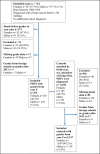Nationwide, population-based study of school grades in practical and aesthetic subjects of children treated for brain tumour
- PMID: 32201746
- PMCID: PMC7073787
- DOI: 10.1136/bmjpo-2019-000619
Nationwide, population-based study of school grades in practical and aesthetic subjects of children treated for brain tumour
Abstract
Background: Children treated for brain tumour (hereafter termed paediatric brain tumour survivors (PBTS)) often need extra support in school because of late-appearing side effects after their treatment. We explored how this group of children perform in the five practical and aesthetic (PRAEST) subjects: home and consumer studies, physical education and health, art, crafts and music.
Methods: In this nationwide population-based study of data from the Swedish Childhood Cancer Registry and Statistics Sweden, we included 475 children born between 1988 and 1996, diagnosed with a brain tumour before their 15th birthday. We compared their grades in PRAEST subjects with those of 2197 matched controls. We also investigated if there were any differences between girls and boys, children diagnosed at different ages, and children with high-grade or low-grade tumours.
Results: The odds for failing a subject were two to three times higher for girls treated for a brain tumour compared with their controls in all five PRAEST subjects, whereas there were no significant differences between the boys and their controls in any subject. PBTS had lower average grades from year 9 in all PRAEST subjects, and girls differed from their controls in all five subjects, while boys differed in physical education and health and music. PBTS treated for high-grade tumours neither did have significantly different average grades nor did they fail a subject to a significantly higher extent than PBTS treated for low-grade tumours.
Conclusions: Children treated for a brain tumour, especially girls, are at risk of lower average grades or failing PRAEST subjects. All children treated for brain tumour may need extra support as these subjects are important for their well-being and future skills.
Keywords: epidemiology; oncology; school health.
© Author(s) (or their employer(s)) 2020. Re-use permitted under CC BY-NC. No commercial re-use. See rights and permissions. Published by BMJ.
Conflict of interest statement
Competing interests: None declared.
Figures
References
-
- Gustafsson G, Kogner P, Heyman M. Childhood Cancer Incidence and Survival in Sweden 1984-2010, 2013. Available: http://www.forskasverige.se/wp-content/uploads/ChildhoodCancerIncidencea...
LinkOut - more resources
Full Text Sources


